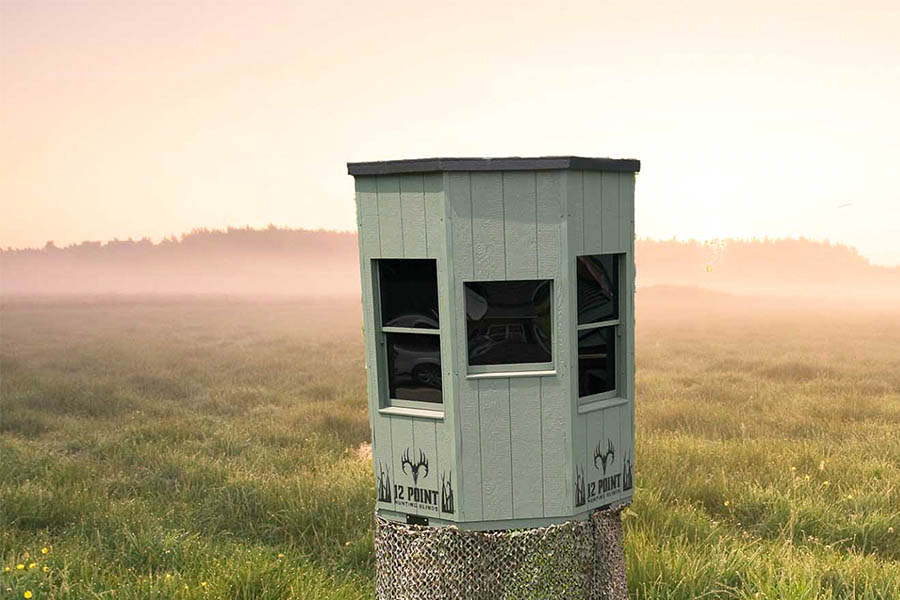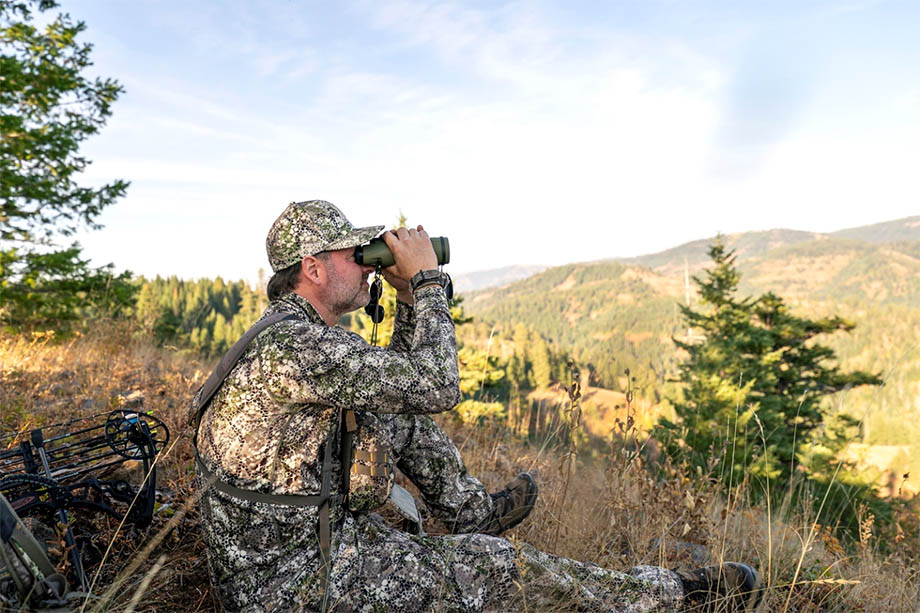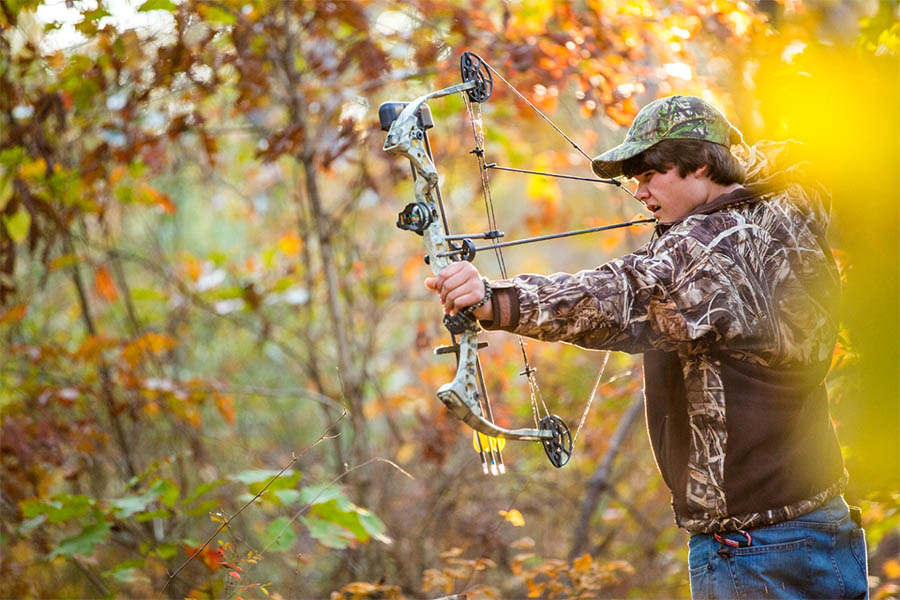Hiding in Plain Sight: How to Stay Hidden in a Blind
When trying to blend in on a hunt many hunters opt for a blind and it is easy to see why. Using a blind, whether a box blind, portable blind, or a simple hole in the ground allows hunters to stay out of sight for longer. Of course, this increases the likelihood that unsuspecting prey may wander or fly through without suspecting a thing, giving hunters a clear advantage.

While hunting with a blind does give hunters an edge, there is more to staying hidden than climbing into the blind and waiting. Animals quickly become wary of unnatural-looking structures or patterns in their environment, particularly if they live in the surrounding areas. This is why it is critical that you consider a few elements before setting off on your big hunt. In this article, we will outline a few strategies for camouflaging your blind and staying hidden which will increase the chances of a successful hunt.
Be Sure to Choose the Right Location
Before you can begin to think about how to camouflage your blind it is important to choose a great location for your hunt. This will vary based on species and time of year, however, generally speaking, you want to set your blind with the sun at your back and downwind of where you think game is. While not a perfect science, getting boots on the ground before the hunt can help you to see travel routes and identify any areas that might hold game.

There are also circumstances where you may be able to hide more effectively using elements of the natural environment such as a hill or berm, rock outcroppings, or areas of thick brush. In these cases, you should consider building your blind to maximize the landscape and allowing your hunting blind to blend in. Doing so reduces the time it takes you to set up the blind and will likely lead to a more natural-looking blind.
Think About the Type of Blind You Will Use
Like anything in hunting, different tools can perform different tasks, blinds are no different. Before camouflaging your blind, consider which type of blind you will use. Some of your options are below along with factors to think about when trying to stay hidden:
- Portable ground blind – Just as their name implies, these blinds can be carried to different locations and be used pretty much everywhere. While you may be able to choose a blind pattern that matches your environment, there is a good chance that you will need to customize a bit to blend in. Adding camo netting can help as can adding in local vegetation. One downside of portable blinds is that they offer little in the way of protection from the elements and the inside temperature of the blind may match that of the outside air.
- Permanent ground blind – Like the portable ground blind, the permanent ground blind sits on the ground. A permanent ground blind may have more customizable options and can blend in with the natural surroundings nicely using a combination of natural materials and man-made materials including paint and camo netting.
- Raised box blind – A raised box blind can be a great choice because it gives you the advantage of height, taking the bulk of your blind out of the normal sight line of game on the ground and allowing you to see for long distances. Like a ground blind, a raised box blind can be highly camouflaged using natural and artificial materials.
- Natural vegetation blind – While having a premade blind can be more convenient, warm, and effective, it is also possible to build a blind out of completely natural materials. On public property where building permanent structures isn’t allowed, using natural limbs, sticks, and leaves can make an effective blind. The key is to use materials from the area that you are in so that you can blend in more effectively.
Choose Camouflage Materials
One of the biggest things to think about when setting up any type of blind in a new area is to choose materials that blend in with your current surroundings and conditions. We can divide these materials into two categories, man-made or artificial materials, and naturally occurring materials. For many hunters, the best option is a combination of the two.
Let’s start with artificial materials. For me, this always starts with your base layer of the blind, this could be plywood, fabric, or in some cases, metal fencing or the like. Blinds made from wood should always have a base layer of paint that roughly fits in with the area you are in. This could be a shade of green, grey, tan, or even a custom camo pattern. The key is to avoid bright colors and give your blind a starting point to blend in. If you have a fabric blind, sometimes you have a choice in fabric or patterns, it is best to choose a camo pattern that matches your hunting area as closely as possible. There is also custom camo fabric and camo netting that you can drape over just about any blind to help it blend in. Camo netting is also effective because you can easily stick branches or leaves in for an even more effective look.

After you have your base camouflage strategy in place it is almost always a good idea to add some natural elements to enhance the effect. The best and easiest way to do this is often to get to your blind early or the day before and walk around collecting sticks, branches, leaves, and grasses to attach to the blind. Think about creating a natural-looking pattern while leaving distinct lanes for you to shoot through. If no materials are in the area, you may collect materials from another location beforehand and bring them in if permitted.
Think About the Season
An often overlooked element of camouflage is thinking about the season. Hunting in the snowy winter will require different camo than hunting in the late spring or early fall. Seasons also vary by area, so it is important to know how the time of year impacts the area you are hunting. Generally speaking, in the fall and winter you may want a tan base or fabric that looks like dead vegetation and in the spring, you will need a more robust-looking green base. However, if there is a lot of snow, it may be helpful to find some white camo netting to cover up darker colored blinds.

In many cases, the issue of seasonality can be solved, once again, by using naturally occurring vegetation in the area. The vegetation will shift with the seasons, in fall leaves change colors, dry out, and drop, in the spring they are green and vibrant. Collecting these natural elements and adding them to your blind ensures that you at the very least match the season of your hunting area.
Hide Your Scent
Hiding from your target species is about more than hiding visually, many animals have an excellent sense of smell that can give you away well before they ever see your blind. Covering up and hiding this scent is critical to improving your chances of bagging an animal and having a successful hunt. In general, getting rid of your scent involves two main strategies, using scent-blocking products and strategically placing your blind in a place to disperse scent.
Using Scent-Blocking Products
Hunters may use a variety of scent-blocking products that are available on the market. These may include wearing clothing made out of fabric that blocks scent, using scent-blocking chemicals or sprays, and using a blind that is made out of a material that minimizes scent. An advantage to these items is that you can use them and not have to worry about your scent as much, regardless of where you are. The downside is that you may need to reapply sprays and there is no minimum standard of effectiveness for clothing or other scent blocking technology.
For many hunters, using scent blockers is a way to enhance their hiding strategy, but it isn’t their sole method of avoiding scent detection. More often than not avoiding detection comes down to using solid hunting principles like staying downwind of your prey.
Strategic Placement to Minimize Scent Dispersal
Outside of scent-blocking products, setting up your blind strategically is the best way to minimize scent dispersal and avoid detection. This means scouting. To place your blind effectively you need to know which way the wind tends to blow and how it acts at different times of day. You will want to set up your blind in a spot downwind from where you believe the animals will come. This could mean setting it a bit higher in elevation to avoid updrafts, or, if your blind is portable, looking at the weather report and wind direction before heading out on your hunt.
Like anything in hunting, everything with scent minimization is somewhat a guessing game. You are playing the percentages and hoping that in the end, all of the little things like blind placement add up to a successful hunt.
Wrapping Up
More than anything in hunting, staying hidden is a requirement for a successful hunt. Even though blinds are naturally more concealed than hunting in the open, it is still worth your time and energy to make your blind blend in as much as possible. By using strategies such as choosing the right location, the right type of blind for your hunt, picking materials that blend in, and hiding your scent, you can give yourself an advantage on your hunt and put yourself in a position to find success.
Quietest Windows on the Market!
Buy 12 Point Blinds Online OR Locate a Dealer Near You! CLICK HERE!







